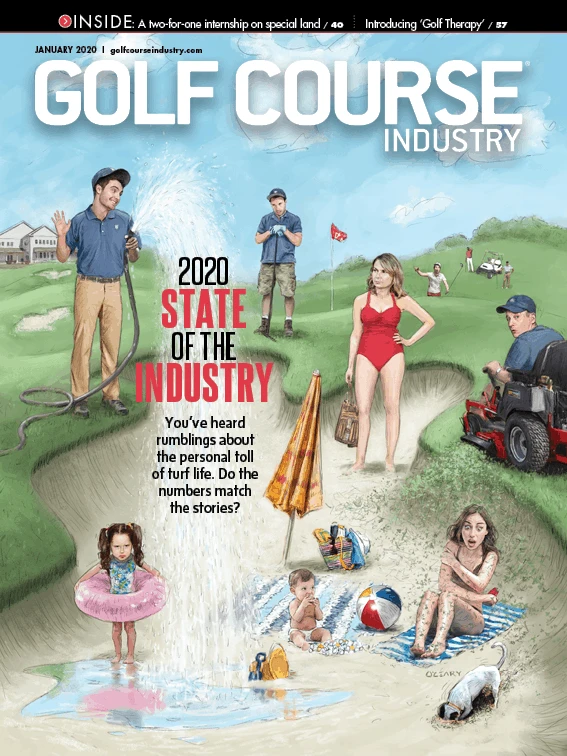
I’ve been writing about golf courses for a very long time, and increasingly have come to appreciate the technical skill set, professionalism and collegiality of superintendents. I only wish the golfing public were equally as understanding.
My first golf course writing came in the early 1980s, for the Canadian golf magazine SCORE. Since then I have plied my hand in a succession of publications – Golfweek, Superintendent News (of which I was founding editor in 1999) and more recently, Golf Channel/GolfAdvisor.com – along with a wide range of freelance outlets, including Links Magazine, Golf Digest, Sports Illustrated, USGA Golf Journal, the New York Times and MET (N.Y.) Golfer, That’s a lot of two-fingered typing. Eight books also followed – all of them explain the way in which maintenance and architecture combined to create the most compelling playing fields in all of sports.
Now with this monthly column in Golf Course Industry, I will be highlighting the many ways in which turfgrass professionals adapt their skills to a rapidly changing golf market.
Over the decades, starting in the mid-1980s, I have also spent a lot of time inside the golf business. That has entailed hundreds of site visits, talks with green committees, boards and memberships – as well as working hand in hand with architects to make sure their planning is sustainable over the long haul.
Whether in the form of course reviews, industry updates or extensive consulting with clubs considering master plans or renovations and restorations, I have been continually amazed and disappointed to find out how little of what superintendents actually do on a day-to-day basis ever really filters down to what golfers think about when they play.
At every facility there’s a certain breed of self-appointed expert who thinks he knows what is best for the golf course. And too often I’ve met folks at clubs whose understanding of course conditions extends no further than the far end of a Stimpmeter – a device, as I like to say, whose use seems to be limited to shoving it up the butt of superintendents in an effort to get them to work harder.
Golfers who judge a course in terms solely of green speeds are like those who think that the criteria for greatness in a golf course are limited to length and difficulty. They miss the point of the game’s beauty, complexity and emotional engagement and they are all too willing to press their agenda against the best interest of the majority of real golfers. And they do real damage to the morale and career path of superintendents as well.
I figure that about 90 percent of what it takes to make a golf course function well is hidden below the surface in the form of irrigation, drainage, soil composition, water chemistry and root structure. Golfers only see the surface resultant of all those factors. In other words, they see the consequences of the inputs without knowing what went into it. They also rarely see the labor process – the mowing, aeration, seeding and overseeding, raking, watering and drying.
Superintendents also suffer from underexposure. The golf pro has his or her office by the first tee. The first a person a golfer sees before and after a round is usually someone from the pro shop. The greenkeeper, meanwhile, is housed far away – in at least one case I know of, Peachtree Golf Club in Atlanta, with an office in another area code from the clubhouse.
Superintendents are also, by nature, on the shy side, often reclusive. Most seem to prefer working directly with the land, with machinery and dirt, and with that small coterie of turf colleagues with whom they seem to share a private language. They are not, by nature, gregarious mixers. Nor is their comfort zone a corporate board where everyone else is dressed in jacket, tie and white shirt.
And who can blame superintendents for taking comfort in the world they know best? There’s no greater office in the world than the solitude of a golf course as it emerges from early morning darkness into light. For this reason, I often think that superintendents meeting with boards, green committees and municipal boards should have their sessions in the maintenance yard or out on the golf course itself. It’s called meeting on your home turf.
All of these traits and characteristics define the unique work life of superintendents. They are not liabilities, merely elements that have to be considered as superintendents plan their careers. In this column I’ll take all of this into consideration as I explore ways that turfgrass managers can improve both their lot and the wellbeing of the facility where they ply their trade.

Explore the January 2020 Issue
Check out more from this issue and find your next story to read.
Latest from Golf Course Industry
- From the publisher’s pen: Conscientious of a bigger role
- Bernhard and Company partners with Laguna Golf Phuket
- Terre Blanche showcases environmental stewardship
- VIDEO: Introducing our December issue
- Bernhard and Company introduces Soil Scout
- Nu-Pipe donates to GCSAA Foundation’s Centennial Campaign
- GCSAA enhances golf course BMP tool
- Melrose leadership programs sending 18 to 2026 GCSAA Conference and Trade Show





